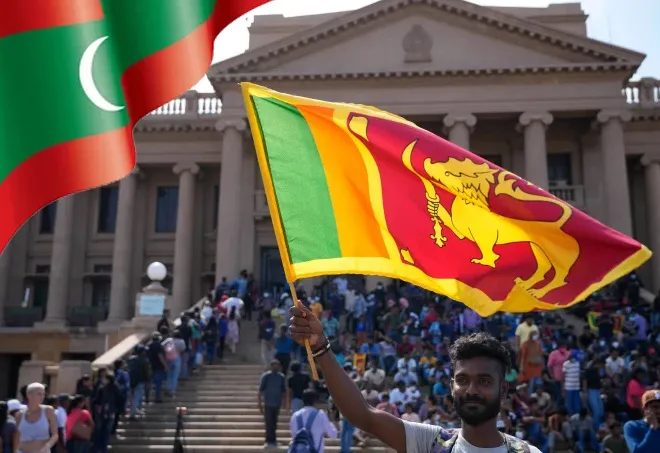
The crisis in Sri Lanka has continued to send severe shockwaves across the Maldives, as both countries have similar external and structural economic features.
Externally, they continue to be haunted by global inflation, the COVID-19 outbreak, and the effects of Russia’s Ukraine invasion.
Structurally, they have continued to sustain their economic growth through extensive borrowing, increasing interest and debt burdens, fewer revenues combined with high expenditure, over-reliance on tourism, and meagre export revenues and diversification. Although a careful assessment of both the countries shows that the Maldives is at a relative economic advantage compared to Sri Lanka, the island nation may face direct political and security implications emanating from the crisis.
An economic paranoia?
Like Sri Lanka, Maldives has traditionally faced
issues such as falling domestic revenues, extravagant public spending, and unsustainable fiscal and debt policies. Overly depending on the tourism and service sector, the Maldives tried to diversify its economy by focusing on mega infrastructure projects since its democratisation in 2009. Many of these initiatives—accelerated by China’s assistance during President Abdulla Yameen’s tenure between 2013–2018—have led to a subsequent increase in debt accumulation and budget deficits. Consequently, Maldives’ expenditure has largely exceeded its revenues (refer to Table 1) and has seen a subsequent increase in the nation's external debt. As the COVID-19 pandemic hindered the tourism industry and thereby Maldives’ GDP (refer to Table 1), these deficits, debts, and borrowings have increased, — triggering a fear that Maldives might end up meeting a similar fate as Sri Lanka.
Table 1. Maldives’ budget deficit, external debt, and GDP
| Year |
2015 |
2016 |
2017 |
2018 |
2019 |
2020 |
2021 |
|
Maldives’ GDP
(in US$ billion) |
4.1 |
4.3 |
4.75 |
5.3 |
5.6 |
3.7 |
4.8 |
| The deficit as a % of GDP |
-6-5 |
-10% |
-3.1% |
-5.3 |
-6.7 |
-23.5 |
-16.5 |
| Total external debt (in US$ billion) |
0.72 |
0.99 |
1.25 |
2.0 |
2.3 |
3.2 |
3.3 |
Source: Maldives Monetary Authority
However, certain factors do put the Maldives at an advantage. The Sri Lankan government continued receiving investments and borrowing loans at high-interest rates since the early 2000s. These investments and (official) lending to
Sri Lanka sum up to US$ 12 billion and US$ 6 billion respectively. On the other hand, the Maldives witnessed this for a shorter duration and that too only under Yameen’s regime. As a result, it officially owes over
US$ 1.5 billion to China and received investments
worth 15 percent of its GDP in 2018 (around US$ 800 million). Thus, reducing the Maldives’ overall borrowing from China and minimising the extent of the debt trap.
Similarly, regardless of the COVID-19 outbreak, Sri Lanka has sustained its growth through extensive borrowing. Its public debt to GDP ratio
was already 91 percent in 2018 and further increased
to 119 percent in 2021. Contrastingly, the Maldives maintained some uniformity with its GDP to debt ratio till 2018 (Table 2). It was only due to COVID that its GDP
contracted and borrowings increased simultaneously.
Table 2. Debt outstanding % of GDP
| Year |
2013 |
2014 |
2015 |
2016 |
2017 |
2018 |
2019 |
2020 |
2021 |
| Debt to GDP ratio (%) |
56.1% |
55.2% |
52.8% |
56.8% |
59.1% |
58.8% |
62.5% |
121.4% |
124.8% |
Source: Maldives Monetary Authority
Finally, in the case of Sri Lanka, the COVID-19 crisis also coincided with its debt maturities. Sri Lanka has to repay over US$ 25 billion out of its US$ 51 billion total debts by the year
2026. The Maldives’ problems, however, are surfacing in a post-pandemic world. The country cleared its biggest near-term loan debt worth
US$ 250 million this June, and the next biggest medium-term matures
only in 2026. On a positive note, the island state is witnessing an annual GDP growth
of 7.6 percent, and its foreign reserves have
increased from US$ 600 million in 2019 to US$ 829 million in April 2022. The budget deficit is also gradually narrowing with an estimation of
-11 percent for 2022.
Political and security Implications
However, unlike this economic paranoia, the Sri Lankan crisis poses direct security and political implications for the Maldives. Firstly, the crisis is likely to sharpen the partisan nature of the country’s foreign policy as the competition between India and China intensifies. The ruling party — the Maldivian Democratic Party (MDP) will likely use the Sri Lankan crisis as an example of the Chinese debt trap and will continue to criticise Yameen’s pro-China policies and anti-Indian rhetoric. It is also less likely that the government would step up its balancing between India and China, considering how the balancing game in Sri Lanka
shaped China’s response to the crisis. The MDP government will thus continue to further ties with India, as seen with president Solih’s
visit in early August 2022. On the other hand, considering Yameen’s anti-India rhetoric and personal relations with China, it is less likely that he would balance both, even in case of a change in guard. As the Rajapaksa incident might have shown, Yameen will also have to appease and abide by Chinese interests to tap into their economic and political benefits, which will very likely come at a cost for India.
It is also less likely that the government would step up its balancing between India and China, considering how the balancing game in Sri Lanka shaped China’s response to the crisis.
Secondly, Maldives has already been a victim of an unstable Sri Lanka. The People’s Liberation Organisation of Tamil’s Eelam (PLOTE)’s attempt to
overthrow the Maldivian government in 1988 will likely continue to ring alarm bells of the potential threats emanating from the Sri Lankan crisis. In recent years too, the island state is developing an
institutionalised relationship with New Delhi and Colombo to counter maritime threats, terrorism, drug and arms trafficking, organised crimes, illegal fishing, natural or human disasters, etc. Being the smallest country with no navy, the Maldives has been mutually dependent on India and Sri Lanka for its maritime and physical security. This cooperation is crucial and timely as it could limit the trafficking networks that can exacerbate the country's increasing extremist challenges. A chaotic or crisis-hit Sri Lanka will thus stagnate or even devastate this blooming cooperation, much to the Maldives’ loss. It is for this reason that the
MDP mutually decided to allow Gotabaya Rajapaksa to seek refuge in the country for some time. A
tweet from former President Nasheed, claiming how the Maldivian government helped Sri Lanka move forward, further substantiates the anxiety emanating from an unstable Sri Lanka.
Conclusion
Despite sharing similar economic features, the Sri Lankan crisis will likely have more impact on the Maldives’ security and politics. This is not to say that the Maldives’ economy will always be immune to external shocks. One thing the Maldives should learn from the Sri Lankan crisis is the consequence of deferring much-needed structural reforms. The country has no option but to increase its revenues, diversify its forex sources, and minimise its overall borrowing and unsustainable expenditure. It should also prepare itself to cope with the potential political and security challenges emanating from the crisis, as the great power rivalry intensifies and Sri Lanka continues to be on the brink of a collapse.
The views expressed above belong to the author(s). ORF research and analyses now available on Telegram! Click here to access our curated content — blogs, longforms and interviews.



 The crisis in Sri Lanka has continued to send severe shockwaves across the Maldives, as both countries have similar external and structural economic features.
The crisis in Sri Lanka has continued to send severe shockwaves across the Maldives, as both countries have similar external and structural economic features.  PREV
PREV


